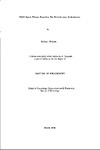Multi-Agent Fitness Functions For Evolutionary Architecture
| dc.contributor.author | Holden, Richard | |
| dc.contributor.other | Faculty of Science and Engineering | en_US |
| dc.date.accessioned | 2013-11-07T13:35:47Z | |
| dc.date.available | 2013-11-07T13:35:47Z | |
| dc.date.issued | 2005 | |
| dc.identifier | NOT AVAILABLE | en_US |
| dc.identifier.uri | http://hdl.handle.net/10026.1/2673 | |
| dc.description.abstract |
The dynamics of crowd movements are self-organising and often involve complex pattern formations. Although computational models have recently been developed, it is unclear how well their underlying methods capture local dynamics and longer-range aspects, such as evacuation. A major part of this thesis is devoted to an investigation of current methods, and where required, the development of alternatives. The main purpose is to utilise realistic models of pedestrian crowds in the design of fitness functions for an evolutionary approach to architectural design. We critically review the state-of-the-art in pedestrian and evacuation dynamics. The concept of 'Multi-Agent System' embraces a number of approaches, which together encompass important local and longer-range aspects. Early investigations focus on methods-cellular automata and attractor fields-designed to capture these respective levels. The assumption that pattern formations in crowds result from local processes is reflected in two dimensional cellular automata models, where mathematical rules operate in local neighbourhoods. We investigate an established cellular automata and show that lane-formation patterns are stable only in a low-valued density range. Above this range, such patterns suddenly randomise. By identifying and then constraining the source of this randomness, we are only able to achieve a small degree of improvement. Moreover, when we try to integrate the model with attractor fields, no useful behaviour is achieved, and much of the randomness persists. Investigations indicate that the unwanted randomness is associated with 2-lattice phase transitions, where local dynamics get invaded by giant-component clusters during the onset of lattice percolation. Through this in-depth investigation, the general limits to cellular automata are ascertained-these methods are not designed with lattice percolation properties in mind and resulting models depend, often critically, on arbitrarily chosen neighbourhoods. We embark on the development of new and more flexible methodologies. Rather than treating local and global dynamics as separate entities, we combine them. Our methods are responsive to percolation, and are designed around the following principles: 1) Inclusive search provides an optimal path between a pedestrian origin and destination. 2) Dynamic boundaries protect search and are based on percolation probabilities, calculated from local density regimes. In this way, more robust dynamics are achieved. Simultaneously, longer-range behaviours are also specified. 3) Network-level dynamics further relax the constraints of lattice percolation and allow a wider range of pedestrian interactions. Having defined our methods, we demonstrate their usefulness by applying them to lane-formation and evacuation scenarios. Results reproduce the general patterns found in real crowds. We then turn to evolution. This preliminary work is intended to motivate future research in the field of Evolutionary Architecture. We develop a genotype-phenotype mapping, which produces complex architectures, and demonstrate the use of a crowd-flow model in a phenotype-fitness mapping. We discuss results from evolutionary simulations, which suggest that obstacles may have some beneficial effect on crowd evacuation. We conclude with a summary, discussion of methodological limitations, and suggestions for future research. | en_US |
| dc.language.iso | en | en_US |
| dc.publisher | University of Plymouth | en_US |
| dc.title | Multi-Agent Fitness Functions For Evolutionary Architecture | en_US |
| dc.type | Thesis | |
| plymouth.version | Full version | en_US |
| dc.identifier.doi | http://dx.doi.org/10.24382/4635 |
Files in this item
This item appears in the following Collection(s)
-
01 Research Theses Main Collection
Research Theses Main


